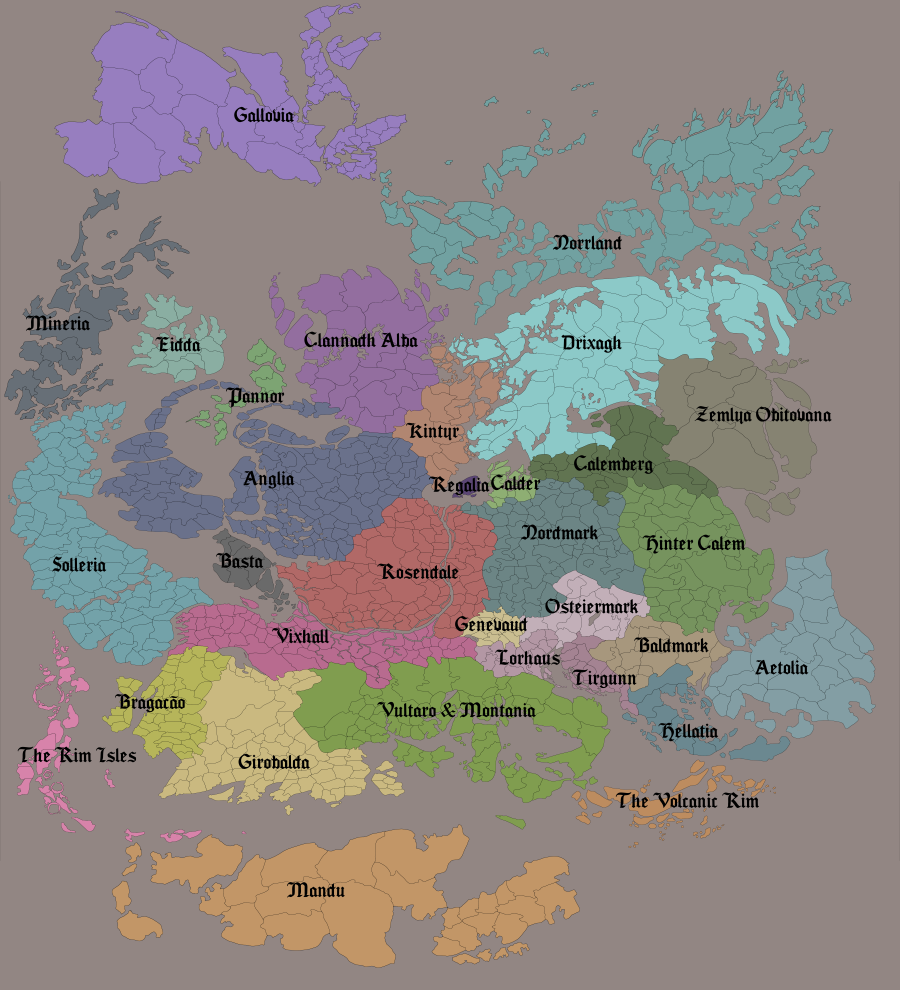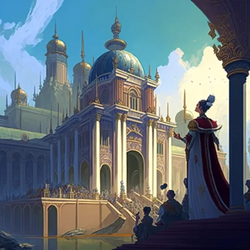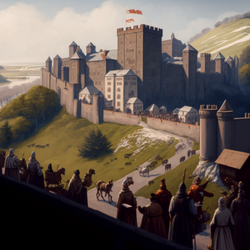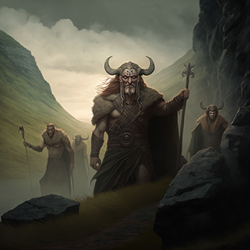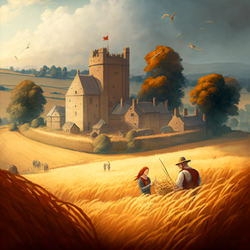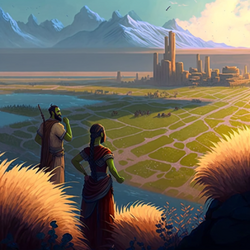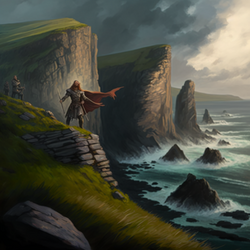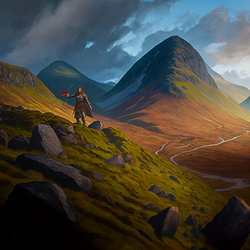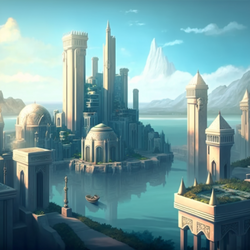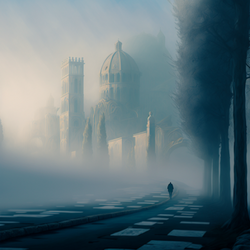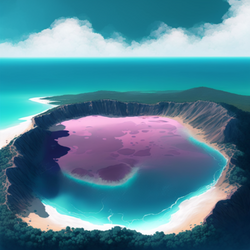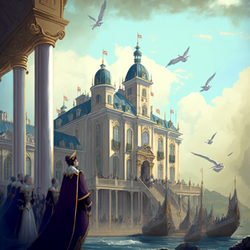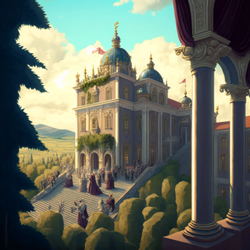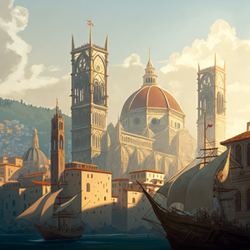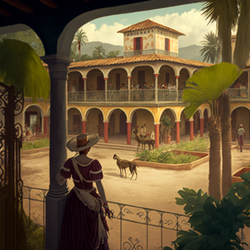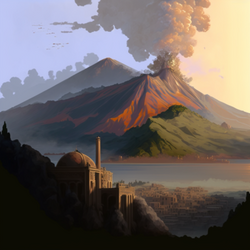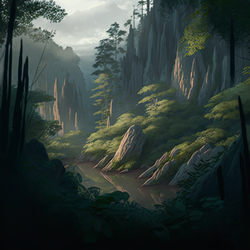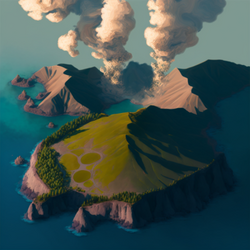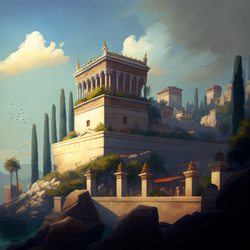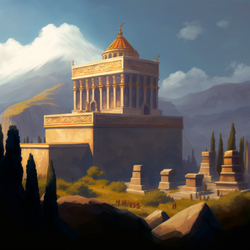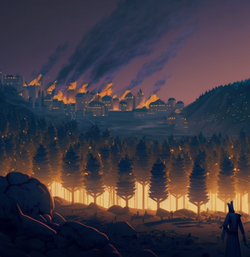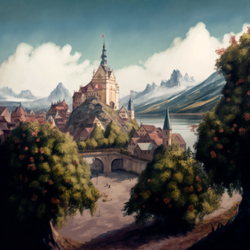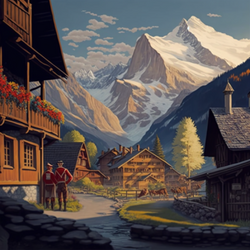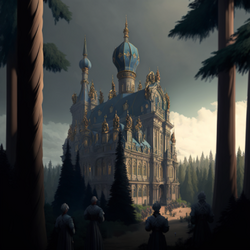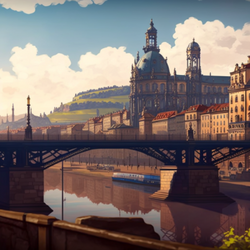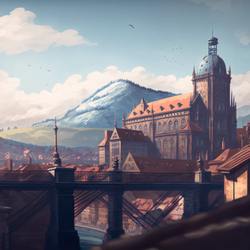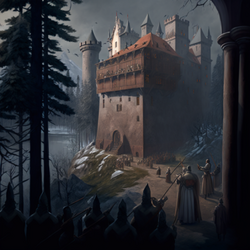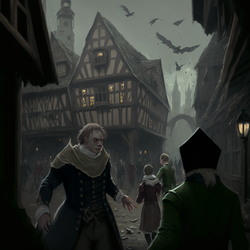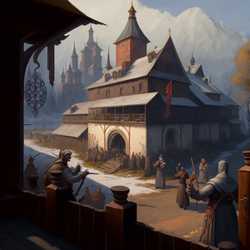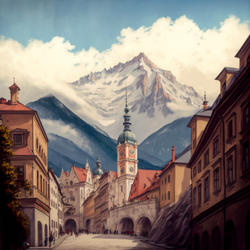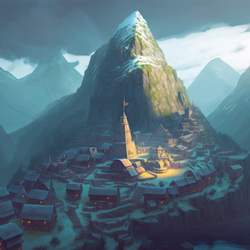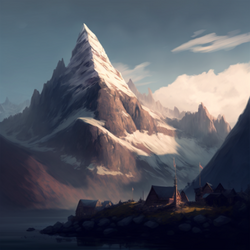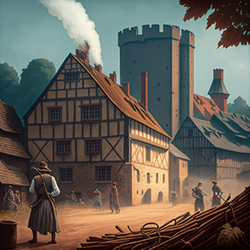More actions
No edit summary |
No edit summary |
||
| Line 134: | Line 134: | ||
| colspan="2" style="background-color:white;" | | | colspan="2" style="background-color:white;" | | ||
Lorhaus is the most peaceful of the three Leutz-Vixe provinces together with Osteiermark the political one, and Tirgunn the violent one. Lorhaus is settled at the foot of the Genevaud Alps, and mostly has peaceful valleys, artsy towns, and extensive fruit plantations. Lorhaus perfume and fruit jellies are famous across the Empire, just as famous as the small lake-side towns where artists come to paint the scenery. Lorhaus is one of the provinces with the largest Teledden minorities present, outside of Solleria which is where most of the Elves live, and Girobalda which has a sizeable Suvial population on its eastern shores. Lorhaus is also rich in fine crafts like glass-blowing and crystal cutting, making it a popular location for the wealthy to spend their money. | Lorhaus is the most peaceful of the three Leutz-Vixe provinces together with Osteiermark the political one, and Tirgunn the violent one. Lorhaus is settled at the foot of the Genevaud Alps, and mostly has peaceful valleys, artsy towns, and extensive fruit plantations. Lorhaus perfume and fruit jellies are famous across the Empire, just as famous as the small lake-side towns where artists come to paint the scenery. Lorhaus is one of the provinces with the largest Teledden minorities present, outside of Solleria which is where most of the Elves live, and Girobalda which has a sizeable Suvial population on its eastern shores. Lorhaus is also rich in fine crafts like glass-blowing and crystal cutting, making it a popular location for the wealthy to spend their money. | ||
|- | |- | ||
| style="text-align:center; width:15%; background-color:#efefef;" | | | style="text-align:center; width:15%; background-color:#efefef;" | | ||
| Line 176: | Line 170: | ||
| colspan="2" style="background-color:white;" | | | colspan="2" style="background-color:white;" | | ||
Baldmark is a strange province, in that it seems relatively unremarkable at first. It has large cities, a wealthy population and sizeable peasant class, with both pious Unionist centers like the Temple cities of Tirgoviste and Vargoviste, but is also home to the pagan tribes still native to the area, least of all the Szabadok. Yet, in Baldmark, there is a permanent struggle between the forces of good and evil. Sizeable violent and cruel Void worship circles hide in the undercities, hunted by the Lothar Knights, while Vampires are rumored to rule whole cities while hiding their identity. Baldmark is generally avoided by outsiders, largely because the province is very dangerous, and because that danger is not very obvious on first inspection, but lurks around every corner. There is always some plague or some calamity terrorizing Baldmark. | Baldmark is a strange province, in that it seems relatively unremarkable at first. It has large cities, a wealthy population and sizeable peasant class, with both pious Unionist centers like the Temple cities of Tirgoviste and Vargoviste, but is also home to the pagan tribes still native to the area, least of all the Szabadok. Yet, in Baldmark, there is a permanent struggle between the forces of good and evil. Sizeable violent and cruel Void worship circles hide in the undercities, hunted by the Lothar Knights, while Vampires are rumored to rule whole cities while hiding their identity. Baldmark is generally avoided by outsiders, largely because the province is very dangerous, and because that danger is not very obvious on first inspection, but lurks around every corner. There is always some plague or some calamity terrorizing Baldmark. | ||
|- | |- | ||
| style="text-align:center; width:15%; background-color:#efefef;" | | | style="text-align:center; width:15%; background-color:#efefef;" | | ||
Revision as of 08:50, 24 December 2022
This page is a sub-page of the Geography page which records all major regions of the Alorian world, and explains roughly what each Nation or area is like. Northbelt in particular is in the north-western direction of Regalia, home to many Ailor, Sihndar, and Urlan realms, each with varied and often conflicting history. Some of these pages may be tied to more expansive lore, which is linked within their respective table rows. Below is a piece of the Geography map cut out to show the relation between all the nations geographically.
| Name | Description | |
|---|---|---|
|
Regalia is the Imperial crown of the Regalian Empire, the capital of capitals, the city of light, and the epicenter of all imperial ambition and politics. It is a city of over 4 million inhabitants, supported with daily shipments from the surrounding provinces, where wealth and class gaps are the strongest across the Empire. From the poorest of poor citizens in Crookback to the wealthiest of citizens in the Imperial District and the Holy Seat where the Emperor's Palace (pictured) resides, Regalia is both a city where one can find anything that the heart desires, but also the deepest and most profound miseries. This is where most roleplay on the server takes place. The whole island is one massive artificial oddity in the world, a city carefully balancing on the edge of famine and unrest, with wildlife long extinct, and many ancient ruins that still emit power into the imagination of the citizens. | ||
|
Kintyr is the land of castles, the land of chivalry, and the land of forever tournaments. Kintyr was one of the pivotal regions that supported the Five Family Rebellion and helped found the Regalian Empire (which upon founding, only covered Anglia, parts of Rosendale, Solleria, and Kintyr, having to conquer the rest). Kintyr is home to the Breizh Ailor, as well as the Aelrrigan Knight Order. It is a land of immense cultural cohesion, but political divisions, with the local petty kings and dukes constantly fighting over scraps of land, despite the Iron truce denying the nobility the right to go to war with one another. Kintyr has the highest density of castles, with many more abandoned and razed during sieges. Kintyr stone masons are renowned across the Empire for building the most durable and solid castles, having weathered many assaults to learn the right structural techniques. | ||
|
Clannadh Alba is one of the last regions in the Regalian Archipelago that still houses its own native tribes the Gamorr people, an ancient pagan Ailor people who largely avoid contact with the Empire. Clannadh Alba itself is a rugged land of fjords and mountains, with internal conflict as much of the population was turned into Urlan, with the few Ailor holdouts resisting further Urlan Symbiosis, a fragile truce keeping the two races apart from one another. Clannadh Alba is often ignored in the bigger picture of Imperial politics, lacking any real importance to the Empire at large and also providing very little to the march of progress. Rural tribes such as the Gamorr live in relative peace here, unbothered by the relentless industrialization that occurs elsewhere in the Empire, and far out of the reach of Unionist missionaries. | ||
|
Anglia is the breadbasket of the Empire as well as its founding place of origins. Through both skillful use of political privileges as well as its exceptionally mild climate, Anglia has become the place that provides food for nearly the entire empire and especially the capital which receives daily shipments from its grain stores. Anglia is an ancient land with ties to the Dragons and pre-Empire history, also making up part of the bulk of what was once the Regalian Kingdom before the Five Family Rebellion. Anglia is ruled nearly in its entirety by House Kade, the Imperial royal family, who spent the last 300 years using a vast network of political marriages to partially unify Anglia in a patchwork of feudal contracts and land ownership deeds. Anglia remains also a very bigoted land, the locals not looking kindly on non-Unionist, non-Dragon-worshiping Ailor, or even just other provincial outsiders as strangers. | ||
|
Pannor, once called the islands of Medway, is the land grant given to the Eronidas who wished to join the Regalian Empire and settle in the archipelago. Medway was once considered a very poor land, mostly barren salt flats and mineral poor mountains, though the hardy Eronidas have made a living on Pannor and even founded several city states that remain very wealthy to this day. Pannor has a harmonious Ailor Eronidas mixed population that results in also plenty of religious overlap. Many half-Eronidas come from Pannor to Regalia in search of their culture or a future legacy. Many Eronidas from Pannor itself make up the bulk of the Regalian frontline soldiers, first to jump into any war that the Emperor points his scepter towards. | ||
|
Eidda is a strange land, once entirely uninhabited, now largely colonized by Gallovian Ailor settlers, specifically from the Emerald Isles before it fell into Allorn hands. Eidda is rocky, wet, and difficult to approach on account of the very jagged and sharp cliffs on the coastlines, with few natural harbors that give way to calm waves. Eidda is, despite its location surrounded by more urbanized lands, incredibly isolated from the Regalian Empire precisely because of the logistical difficulty of actually reaching it. Many of the locals thus live a life of relative autonomy by circumstance, not paying much if anything in taxes. Eidda as such has also become known as the land where brigands and criminals go to stay within the Empire to lay low, but avoid the authorities to not end up in jail. | ||
|
Gallovia is the homeland of the kiltach, the vielt, and all other things Gallovian Ailor. It is a land of extreme contrast, between the highly urbanized Kinwry capital of the region, and the extremely sparsely populated Talahm Gall regions, where legend has it Marken roam free in worship of their old Pagan gods. Gallovia is the home of the Gallovian Ailor, who would eventually settle Eriu Innis, Eidda, and Clannadh Alba, and remains the most numerous of all these places. Between the rocky glens, the deep snowy mountains and the rough coasts, it is a poor land, but on the periphery of the Empire, its people appreciate their relative independence and apathy to the politics of the capital, and is as such seen as a land of tradition and old customs. | ||
|
Mineria is one of the more recently populated regions in the archipelago with a very unique architectural style quite unlike anything else in the world. Its predominantly Fin'ullen and Kathar populations as well as Anglian immigrants have developed so-called Naut-Cities, which are cities perfectly blending with the sea, where some roads end up into the water, and carts give way for boats. Many of these cities are inhabited by semi-aquatic Fin'ullen, but more notably, it is a place where Void Worship is very common and often seen as the dominant religion in the region. It is one of the few places in the Empire where Kathar can exist without any discrimination and scrutiny from higher authorities. | ||
|
Solleria is the land of forever mists and home to the Solvaan Elves who so long ago settled these lands during the waning millennia of the Allorn Empire. When the Allorn Empire fell, the Solvaan under the guidance of their goddess Sinnavei joined forces with the Five Family Rebellion forces, and founded the Regalian Empire, becoming its vanguard. Solleria itself is a land deeply shrouded in eternal mists, both magically summoned and natural. Many monsters lurk in these mists, protecting the cities, archives, and training grounds of the mist-wardens of Sinnavei, who herself remains at her temple-complex the High Chair of Windwhere, high up in the mountains. Solvaan Elves from Solleria make up another sizeable part of the Regalian Army. | ||
|
The Rim Isles are an alien landscape that is sparcely populated. Many of the landmasses as well as the ocean parts are covered in huge craters of some kind of celestial event that took place millennia ago. Many of the craters in the Rim Isles produce curious and sometimes even magical phenomena that are still not understood to this day. The oddities as well as some of the rare algae that live in the region have attracted large numbers of Allar who have settled in the area, and produced some of the first Digmaan realms away from Hadar. The most notable of the Rim Isles's craters is the Jaykhart crater, which during summer turns entirely pink as the algae oversaturate the waters. | ||
|
Basta is one of the so-called Imperial pearls, one of the regions where the wealthy and aristocracy reside and engage in the game of politics. Basta is predominantly inhabited by Ithanian Ailor, though many of them have abandoned their classical cultural roots and embraced Regal traditions, becoming more one with the visions of Empire than their old native homeland. Basta is a major exporter of high art and philosophy, with its wealthy cities being home to many of the Empire's great thinkers. Basta is sometimes also called the land without poverty, because the local governors quite literally shipped all the poor people off the land to Anglia, demolishing their old town homes to build more palaces. The only poor that remain on Basta now are in the service industry. | ||
|
Vixhall is very similar to Basta, though is more of what Basta aspires to be, which is the land of forever partying. Basta is inherently tied to the fames and fortunes of House Ivrae de Sange, the previous Imperial Royal house which ruled the Regalian Empire, before they ran out of heirs and the throne passed to a Kade. In the settlement, House Ivrae de Sange received Vixhall as a royal commission, and has since ruled from there with a level of benign neglect, preferring a life of luxury and opulence over actual rule. Vixhall is /the/ place to be for the hottest trends, parties, and gossip. It is also filled with immense vineyards and plantations, all to produce high-society goods for the ruling classes and the Empire at large, making ample use of Ithanian craft skills. | ||
|
Bragacão was once a very poor region that saw immigration waves from Daen and Lusits, mostly poor migrants wanting to avoid the political chaos in the governorates, but also seeking a better life closer to the Empire. For better or worse, they never made it to the city, but brought with them the nautical skills of the Lusits and Daendroque crafts. What was otherwise a fairly poor region, quickly became the gateway to the west, where all shipping from the western realms arrives, before it is shipped up the Shoenn river to the capital and the surrounding lands. Bragacão is home to the largest shipping and merchant fleets, with any well to do shipping guild having their head office in the capital of Portimão. | ||
|
Girobalda is the land of the unbound personal liberties, that as of yet still has issues letting go of its oppressive past and slavery. Girobalda remains the land of plantations of cotton, hemp, and all manner of exotic fruit and spice production, but still grapples with a cruel past. It was originally just large forest lands, which were skillfully cut and burnt by Daendroque immigrants, and turned into vast slave-manned plantations. While Girobalda was the first region to do away with slavery fully when the Emperor banned all non-service sector slavery, it is still a region with a high criminal past, as well as trouble with Unionist blasphemers hiding in the dense jungles, requiring the Holy Herebrand Order of Knights to come and purge their falsehoods to the Emperor and Everwatcher. | ||
|
Vultaro and Montania were two formerly seperated regions now united under the rule of the Iron Duke Lampero from the capital Lampeport (pictured) at the foot of three massive volcanoes. Montania, otherwise known as the land of fire, and Vultaro otherwise known as the land of mineral wealth, are the major mining hubs of the Regalian Empire, feeding the Empire's huge coal and iron ore needs to keep the technicians and artificers in the capital supplied. Vultaro is also the home of the Supremoclast rebellion, a group of priests who abandoned dogmatic Unionism in the second schism and formed their own religious community, eventually merging with Emended Unionism. Vultaro and Montania remain the home of high-culture music and song, with some of the most renowned composers and mining magnates coming from this region. Most cities in Vultaro are built out of the unique and distinct yellow volcanic tuff that is also becoming more popular in the capital. | ||
|
There is not much to be said about Mandu bereft of modern happenings. For hundreds of years, Mandu was not inhabited, both because its climate was unpleasantly humid and the land itself unpleasantly rocky. For some reason, despite the massive rainforests growing on it, the soil itself is incredibly stone-like, and jagged, strangely jagged even. In recent years, Mandu has become a prime colonizing location for Asha and Maquixtl immigrants, who are more prone to accepting harsh living conditions that they can either adapt to, or shape to their own whims with Asha terraforming. Mandu was once intensely isolated because the surrounding regions were barely populated, but more and more ferry services are being established. | ||
|
The Volcanic Rim has many names, but all of them are usually labels defined by immigrant groups, many of them conflicting the next group's definition, and as such, the Volcanic Rim remains the most commonly used. The Volcanic Rim does not exist on any old pre-Empire maps, because the Volcanic Rim only formed through volcanic eruptions in the past few centuries. It is now home to some Songaskian and Sihai immigrants who find all the other provinces too alien to tolerate migrating or integrating into. As such it is a weird place where one can find native Farah'deen and Dexai architecture existing in a cultural capsule away from Regalia's general architectural styles. It is also a land devoid of any nobility, because the lands have not been formally partitioned for noble rights yet. | ||
|
The Hellatian States are a relatively modern invention of mass-Aetosian re-immigration to the Regalian Archipelago following a series of reproachments and peaceful resolutions between the Dogmatic Unionists and Evintarian Unionists. The Hellatian province is incredibly inhospitable, as it is mainly barren mountain land, but the Aetosians created several prosperous city-states. Unlike Etosil which is ruled by the Aetosian patriarch and the Bone King however, the Hellatian States lack a central authority to keep the local cities in check. As a result, many of the city-states are on conflict with one another, never to the point of violence, but certain to such degree that an unusual level of regional competitiveness exists between the otherwise communal Aetosian Ailor. | ||
|
Aetolia is another one of the Regalian frontier lands that is sparsely populated, though this is entirely by the design of the locals. Aetolia isn't uniquely unhospitable like Hellatia, but unlike Hellatia, the Aetosian Ailor prefer a countryside living style here, with strong undercurrents of monasticism. Many of the citizens in the Hellatian States pay for extensive mausoleums and tombs in Aetolia, making it one of the major burial provinces of the Evintarian Unionists, filled with embalming houses, cloisters, and extensive graveyards. In fact, the mortuary business in Aetolia has been so successful, that even some non-Evintarian nobles and many citizens from Etosil have started buying up tombs in Aetolia due to its peaceful environs. | ||
|
Tirgunn is an unstable province, largely due to the eternal struggle between the dark forces that lurk in its swampy pine forests, and the Darkwald Lothar Knights who seek to purge the land of the Afflicted. Routinely cities in Tirgunn get torched by Vampire attacks and Lothar in turn execute whole villages who are suspected of Vampiric infection. Still, the Leutz-Vixe Ailor in Tirgunn are a hardy people, many of the small forest communities having created extensive defensive fortifications. Tirgunn crossbowmen are renowned across the Empire as some of the most skilled ranged warriors available, many of them having been recruited as retainers for the Lothar Knights to continue the struggle against the Vampires and Cahal in the region. | ||
|
Lorhaus is the most peaceful of the three Leutz-Vixe provinces together with Osteiermark the political one, and Tirgunn the violent one. Lorhaus is settled at the foot of the Genevaud Alps, and mostly has peaceful valleys, artsy towns, and extensive fruit plantations. Lorhaus perfume and fruit jellies are famous across the Empire, just as famous as the small lake-side towns where artists come to paint the scenery. Lorhaus is one of the provinces with the largest Teledden minorities present, outside of Solleria which is where most of the Elves live, and Girobalda which has a sizeable Suvial population on its eastern shores. Lorhaus is also rich in fine crafts like glass-blowing and crystal cutting, making it a popular location for the wealthy to spend their money. | ||
|
Genevaud as a region has largely remained unchanged for the past five hundred years, exactly the way the locals like it. The Genevaud Cantons are a unique element in the Regalian Archipelago in that there are no nobles, rather the Cantons are ruled by republican councils. Genevaud covers most of the Genevaud Alps, a large mountain range with some of them extending west into Vixhall, and east into Lorhaus and Osteiermark. The Genevaud Ailor are an isolationist people, having joined the Empire with promises of autonomy that have lasted to this day, and mostly defying immigration from any stranger, outsider, or non Dogmatic Unionist. The Genevaud Alps are full of small villages and cottages all over the mountains where the locals rear cattle. | ||
|
Nordmark is one of the Imperial provinces together with Basta and Calemberg where many of the ruling noble families and politically active actors come from. Nordmark is considered a bulwark of conservatism, where some of the old money nobility own estates in the dark forests that hug the northern side of the Genevaud Alps and Osteiermark. Nordmark was once part of Rosendale, but the increasingly Wirtem-leaning population eventually split away from the larger Rosendale, and formed their own regional identity. Nowadays, Nordmark competes with Calemberg for the role of pre-eminent military-themed and conservative thought leaders of the Empire, but more often than not do the politicians of Nordmark stick to their isolated countryside estates, dreaming of a world that has largely already passed them by through industrialization, trying to keep a semblance of old nobility alive where the anachronisms of the modern age cannot break the illusion. | ||
|
Calderliga is the trade-capital cousin of Bragacão, where Bragacão manages the trade from the west, Calderliga manages the trade from the east but also the internal network of trade. Calderliga traders for example pick up merchandise from the outer provinces and ship it across the Archipelago, while also dominating the trade through the Shoenn river, the only way to actually reach the capital by boat (as Kintyr's waters are too treacherous and frozen half the year). The Calder province itself is very small, but has a very high population density of wealthy bourgeois, its cities being artistic renditions of the modern age, buildings in elegant palatial styles, interwoven with metal industrial bridges and river barges transporting goods around. The Calder people are Wirtem Ailor, but considered far more progressive than their Calemberg cousins. | ||
|
Calemberg, named after its capital Calemberg (pictured), also known as the second holiest land outside of the Regalian capital itself, is the former Wirtem frontline with Drixagh, and where the Skagger Wars ended and peace was settled. The Calemberg people are fanatically pious and loyal to the Empire, and the homeland of Regalian conservatism, even if recent politics involve fighting with Baldmark over who gets to lead that political current. Calemberg is home to the idea of performative Unionism, where all the wealthy aristocrats try to garner religious and political favor by outdoing each other with increasingly more lavish Unionist Temples as patrons. Calemberg is also where the vast majority of Regalia's military leaders come from, as it is filled with prestigious military academies and schools. | ||
|
Hinter Calem is in many ways the little brother province of Calemberg, one part of the Greater Calemberg region, but having been split off because of an administrative rework of the provinces to accommodate for new population numbers. Hinter Calem is similar to Nordmark in that it is filled with extensive black pine forests where small castles and communities reside. The Wirtem Ailor living in this land are considered rugged frontiersmen, still harboring a lot of hate towards the Velheim Ailor for the Skagger Wars, and generally looking unfavorable to outsiders. Hinter Calem spearmen and swordsmen are some of the most famed warriors of the Empire, and make up the bulk of the Calemberg led armies of the Empire. | ||
|
Baldmark is a strange province, in that it seems relatively unremarkable at first. It has large cities, a wealthy population and sizeable peasant class, with both pious Unionist centers like the Temple cities of Tirgoviste and Vargoviste, but is also home to the pagan tribes still native to the area, least of all the Szabadok. Yet, in Baldmark, there is a permanent struggle between the forces of good and evil. Sizeable violent and cruel Void worship circles hide in the undercities, hunted by the Lothar Knights, while Vampires are rumored to rule whole cities while hiding their identity. Baldmark is generally avoided by outsiders, largely because the province is very dangerous, and because that danger is not very obvious on first inspection, but lurks around every corner. There is always some plague or some calamity terrorizing Baldmark. | ||
|
Zemlya Obitovana is the homeland of the Krainivaya Ailor. Zemlya Obitovana was once called Surrostland by the Skaggers, but the land was conquered in the final Skagger War and given to the Krainivaya people when they fled from their homeland in Essalonia to the Archipelago to avoid magical persecution. Zemlya Obitovana is a poor land, with few fertile soil and mineral riches, but the people are known as the Emperor's most fanatical supporters, having converted to Unionism when they arrived and being some of the most fundamentalist faithful within the Empire. Zemlya Obitovana is known as incredibly unsafe for the Occult, even the legal Mages and Elves, who have a habit of disappearing at the hands of the Oprichna, or the anti-Magic police that is technically in contravention of the law that protects Mages, but still acts with impunity because of the support of the locals. | ||
|
Osteiermark is a densely populated region and the homeland of the Leutz-Vixe people. This region, like Basta, Nordmark and Calemberg, is politically very active, with many of the noble families frequently traveling between its capital Ivenna and Regalia to engage in courtly performances. Osteiermark is a province with many different environments in it, the dark forests of the Carrais vu Lion region, the swampy Hinterlands, and the mountainous regions of western Zellbrücke. Local folklore is immensely rich due to the many tribes that once lived in this area but were displaced by the Ithanians and Wirtem who later mixed and became Leutz-Vixe Ailor. The province is also known as the Empire's workshop for clothing, with many of its internationally renowned designers and clothiers generating vast amounts of wealth from silk and brocade. Osteiermark is also known as a bulwark of monarchism, die-hard supporters of the Imperial administration. | ||
|
Drixagh (actually called Driksenrik in Velheim) is the old homeland of the Skaggers, the legendary Velheim axe warriors which many Regalians still consider dangerous fanatical Old Gods pagans. Drixagh was the scene of successive Skagger wars where the early Regalian Empire struggled in its path of expansion from the reactionary Velheim Ailor. Drixagh was once the most powerful Velheim state in the world, but has since passed its zenith. Following peace with the Regalian Empire and the final defeat of the Skagger lodges, many of the Skaggers emigrated and formed nations like Nordskag, Middeskag and Hvitskag north of Ithania, all of them more powerful and autonomous than Drixagh is nowadays, which has largely been reduced to a province of the Empire, constantly having to fend off attempts from the centralized administration to urbanize them and change their way of life. Drixaghers are known to be some of the most stubborn people in the Empire, proudly defying it in name, but still cowering to the heavy hand of the military and paying taxes. | ||
|
Norrland is the northern most region of the Regalian Archipelago (the map above is shown at an angle, north is actually the top right) and it is seen as one of the poorest regions of the Archipelago. The locals have to survive on subsistence, with many of the outlaying islands being completely uninhabited, with only the local wildlife residing there. Dwarves have started settling on the western islands of Norrland, discovering that even the soil is incredibly poor, and there is nothing of intrinsic value there. The Norrland region was once the scene of heavy fighting between the Skaggers and the Gallovian people from Gallovia during the Skagger Wars. This is why many of the islands are now covered in Helbolwen (velheim Tombs) or Gallovian Cairns where the warriors were buried where they fell. As such, Norrland has, while being materially poor, become a spiritually important place for Old Gods Velheim and Old Gods Gallovians to resolve historical trauma. | ||
|
Rosendale was once known as Dragenthal and Draghe, but the region was renamed to reflect its Commonization and cultural osmosis with Heartland Cearden Ailor, as opposed to the Wirtem Ailor who once lived there. Rosendale is known as the Empire's workshop. The Shoenn River that cuts through it is the main trade artery of the inner Archipelago, but also the scene of hundreds if not thousands of workshops converting raw resources like wool into cotton, which is then shipped further to regions like Osteiermark to be turned into clothing. Every industrial chain of production begins in the workshops and factories of Rosendale, making it the most urban and industrialized province in the Empire, though not necessarily the most peaceful and prosperous one. Many workers live in abject poverty, and the region is still scarred by the conflicts of the Baron uprisings in the past 30 years. | ||
